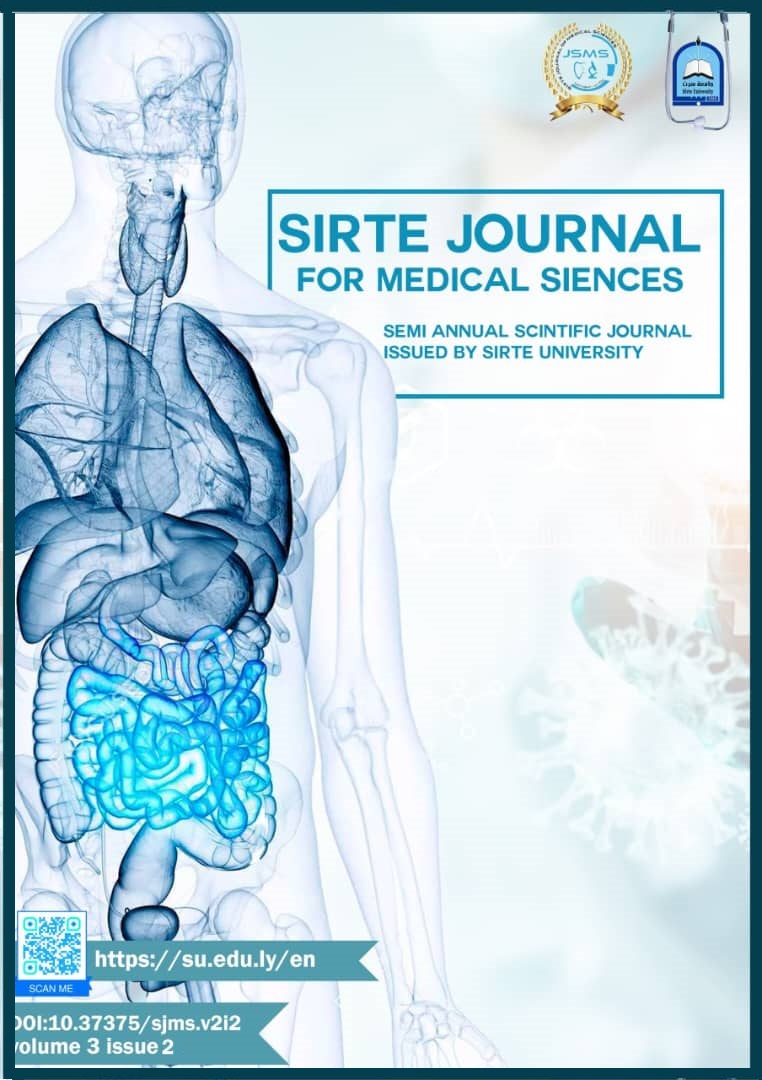Prevalence of UTI Caused by Gram-Negative Bacteria in Type 2DM Cases at Khoums Diabetes Center in Al-khoums, Libya.
DOI:
https://doi.org/10.37375/sjms.v3i2.3172Keywords:
Diabetic mellitus, Urinary tract infection, immune system, LibyaAbstract
Urinary tract infections (UTIs) are more frequent, more severe, and have worse outcomes in individuals with type 2 diabetes mellitus. These infections are also more commonly caused by resistant pathogens. Several factors, including immune system dysfunction, poor metabolic control, and incomplete bladder emptying due to autonomic neuropathy, may contribute to the increased risk of UTIs in these patients. A prospective study was carried out at Khoums Diabetes Center in Al-Khoms, Libya, from December 2022 to February 2023. The study included 170 participants, 140 of whom were diagnosed with type 2 diabetes, while 30 were non-diabetic (control group). Among the 140 urine samples from diabetic patients, 60 samples (42.9%) showed significant bacterial growth, while 80 samples (57.1%) showed no significant growth. When examining the relationship between liquid intake, socio-economic status, and Gram-negative bacterial species, the data was categorized by sex, age, weight, and employment. A higher percentage of females (84%) were affected compared to males (16%). The age group most affected was 46-55 years, comprising 35.5% of cases. Regarding employment, housewives were the most affected group, making up 67.8%, while laborers had the lowest incidence, with 0%. Improving the management of diabetes mellitus, along with the proper use of antibiotics selected based on sensitivity patterns, could help reduce the prevalence of urinary tract infections (UTIs) and prevent renal complications. The results highlighted the rise of highly resistant bacteria to most of the tested antimicrobials, urging physicians to adjust their treatment approaches based on antimicrobial susceptibility findings
References
- Jagadeesan, S., Tripathi, B. K., Patel, P., & Muthathal, S (2022). Urinary tract infection
- and Diabetes Mellitus—Etio-clinical profile and antibiogram: A North Indian perspective.
- National Library of Medicine, 11(5), 1902–1906. https://doi.org/10.4103/jfmpc.jfmpc_2017_21.
- Carrondo MC and Moita JJ (2020) Potentially preventable urinary tract infection in patients with type 2 diabetes—a hospital-based study. Obesity Medicine, 17:100190.
- Marushchak M and Krynytska I (2021) Insulin Receptor Substrate 1 Gene and Glucose Metabolism Characteristics in Type 2 Diabetes Mellitus with Comorbidities. Ethiopian Journal of Health Science, 31(5):1001-1010.
- Maida CD, Daidone M, Pacinella G, Norrito RL, Pinto A and Tuttolomondo A (2022) Diabetes and Ischemic Stroke: An Old and New Relationship an Overview of the Close Interaction between These Diseases. International Journal of Molecular Science, 23(4):2397.
- Lawati, H. Al, Blair, B. M., & Larnard, J (2024). Urinary Tract Infections: Core Curriculum 2024. American Journal of Kidney Diseases, 83(1), 90–100.
- Eckstein ML, Schwarzinger M, Haupt S, Wachsmuth NB, Zimmer RT, Sourij H, Zimmermann P, Zunner BEM, Aberer F and Moser O (2022) Physiological Responses to Combat Sports in Metabolic Diseases: A Systematic Review. Journal of Clinical Medicine, 11(4):1070.
- Rajaobelina K, Dow C, Romana Mancini F, Dartois L, Boutron-Ruault MC, Balkau B, Bonnet F and Fagherazzi G (2019) Population attributable fractions of the main type 2 diabetes mellitus risk factors in women: Findings from the French E3N cohort. Journal of Diabetes, 11(3):242-253.
- Farhadnejad H, Teymoori F, Asghari G, Mokhtari E, Mirmiran P and Azizi F (2022) The higher adherence to a healthy lifestyle score is associated with a decreased risk of type 2 diabetes in Iranian adults. BMC Endocrine Disorders, 22(1):42.
- Nichols GA, Brodovicz KG, Kimes TM, Déruaz-Luyet A and Bartels DB (2017) Prevalence and incidence of urinary tract and genital infections among patients with and without type 2 diabetes. Journal on Diabetes Complication, 31(11):1587–91.
- Wang Z, Hou Y, Huang Y, Ju F, Liang Z and Li S (2022) Clinical efficacy and safety of electro-acupuncture combined with beraprost sodium and α-lipoic acid for diabetic peripheral neuropathy. American Journal of Translational Research, 14(1):612-622.
- Heidemann C, Du Y, Baumert J, Paprott R, Lampert T and Scheidt-Nave C (2019) Social inequality and diabetes mellitus - developments over time among the adult population in Germany. Journal of Health Monitor, 4(2):11-28.
- Ma Y and Chen X (2021) Glibenclamide Ameliorates the Expression of Neurotrophic Factors in Sevoflurane Anaesthesia-induced Oxidative Stress and Cognitive Impairment in Hippocampal Neurons of Old Rats. Journal of Veterinary Research, 65(4):527-538.
- Li F and Chen L (2021) The Association between Trajectories of Anthropometric Variables and Risk of Diabetes among Prediabetic Chinese. Nutrients, 13(12):4356
- 14. Laway, B. A., Nabi, T., Bhat, M. H., & Fomda, B. A. (2021). Prevalence, clinical profile and follow up of asymptomatic bacteriuria in patients with type 2 diabetes-prospective case control study in Srinagar, India. Diabetes & Metabolic Syndrome: Clinical Research & Reviews, 15(1), 455–459. https://doi.org/10.1016/j.dsx.2020.12.043
- Shah MA, Kassab YW and Anwar MF (2019) Prevalence and associated factors of urinary tract infections among diabetic patients. Health Science Journal, 13(2): 1–5.
- Abu-Ashour W, Twells LK and Valcour JE (2018) Diabetes and the occurrence of infection in primary care: a matched cohort study. BMC Infect Diseases, 18(1): 1–8.
- Stephen SJ and Gaharwar R (2019) Effect of glycemic control on the clinical and laboratory profile of UTI in patients with diabetes mellitus. International Journal of Contemporary Medical Research, 6(6): 1–5.
- 18. Laway, B. A., Nabi, T., Bhat, M. H., & Fomda, B. A. (2021). Prevalence, clinical profile and follow up of asymptomatic bacteriuria in patients with type 2 diabetes-prospective case control study in Srinagar, India. Diabetes & Metabolic Syndrome: Clinical Research & Reviews, 15(1), 455–459. https://doi.org/10.1016/j.dsx.2020.12.043.











